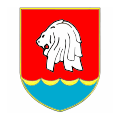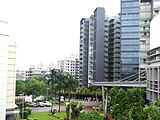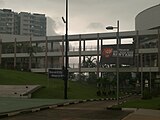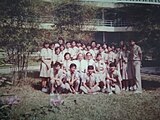Nanyang Junior College
| Nanyang Junior College 南洋初级学院 Maktab Rendah Nanyang நன்யாங் ஜூனியர் கல்லூரி | |
|---|---|
 | |
 | |
| Address | |
 | |
128 Serangoon Avenue 3, Singapore 556111 Singapore | |
| Coordinates | 1°21′03″N 103°52′01″E / 1.3507°N 103.866913°E |
| Information | |
| Type | Government-Aided |
| Motto | 共同建设 (Together We Build) |
| Established | 16 April 1977 |
| Founder | Goh Tjoei Kok (BBM) |
| Session | Single-session |
| School code | 0805 |
| Principal | Pang Choon How |
| Staff | approx. 160 |
| Gender | Mixed |
| Enrolment | approx. 1400 |
| Language | Chinese, Malay, Tamil |
| Colour(s) | Blue Gold Red |
| Song | "共同建设 – Together We Build" |
| Affiliation | Chung Cheng High School Chung Cheng High School (Yishun) |
| Website | nanyangjc.moe.edu.sg |
Nanyang Junior College (NYJC) (simplified Chinese: 南洋初级学院; traditional Chinese: 南洋初級學院; pinyin: Nányáng chūjí xuéyuàn; Wade–Giles: Nan2yang2 Ch`u1chi2 Hsüeh2yüan4) is a junior college in Singapore next to Lorong Chuan MRT station, offering two-year pre-university courses leading up to the GCE Advanced Level examinations.[1]
In recent years, Nanyang Junior College has witnessed a rise in its admission standards.[2] For the past decade, the college has nurtured six Public Service Commission (PSC) Scholarship holders.[3][4][5][6][7]
History
Foundation years
Nanyang Junior College was founded in 1977 as Lorong Chuan Junior College. It was among the first government-aided junior colleges to be established in Singapore.[3] The building committee led by Mr. Goh Tjoei Kok was formed in 1972.[8] Construction of the college began in 1976 with funding and support from the Singapore Chinese Chamber of Commerce and Industry (SCCCI), which concurrently oversees the establishment of Hwa Chong Junior College, Singapore's second junior college and first government-aided junior college.[8]
The college was renamed Nanyang Junior College in December 1977. The name "Nanyang" refers to the "Southern Seas" in Mandarin Chinese. The term was widely used by mainland Chinese people to refer to the region encompassed by Singapore, Malaysia, and the Southeast Asian region. The name is a reflection of the origins of Singapore having been built by immigrants predominantly from China, India, Malaysia, as well as other parts of the world.[9]
The first cohort of about 600 Arts and Science students was enrolled in January 1978. Academic lessons were temporarily conducted at the former Westlake Secondary School campus.[3] Construction of the major buildings and facilities at the permanent site along Serangoon Avenue 3 was completed in November 1978 and started administrative and academic operations the following month.[3] Commerce stream and computer science were introduced into the college in 1979 and 1981 respectively.[8] In 1981, Nanyang Junior College organised the 11th Pre-university Seminar in conjunction with the Ministry of Education.[10][11]
As the campus of Nanyang Junior College was built on a small ridge, fog often covered part of the college in the 1980s and 1990s. Thus, the College was well known affectionately as "白云岗" (Chinese: Literal meaning "White Cloud Ridge"). This is also the inspiration for the brand name of the college's Chinese Cultural Society's annual drama production, "我们的白云岗" (Chinese: Literal meaning "Our White Cloud Ridge").[12]
-
Old NYJC campus in 1980
-
Flag raising ceremony in the hall at the old NYJC campus in 1980.
-
The old building of Nanyang Junior College, taken in 1988.
-
View of the CCA Block of the old NYJC campus in 1988
-
Old science laboratory in 1988
-
The old central garden of NYJC in 1988
-
Campfire at the old NYJC campus in 1988.
-
Students walking through the fog that covered the hilly campus every morning in 1988.
Transformation into a modern institution
On May 21,1995, the College Resource Centre was opened. The three-story building housed the Resource Library, the Computer Centre, the AVA Room, and seminar rooms.[3] In 1997, Nanyang Junior College was selected to be the second college in Singapore to offer the Art Elective Programme (AEP). From January 15, 1999, Nanyang Junior College joined Hwa Chong Junior College and Temasek Junior College as the third pre-university center in Singapore to offer the Chinese Language Elective Programme (C-LEP).[13][14] Nanyang Junior College was selected by the Ministry of Education in 2000 for an on-site re-development of its campus under the PRIME project. in which the Ministry of Education bored 95 percent of the re-development costs.[3] The three-phrase re-development work included the construction of a new main building, which features new science and computer laboratories, a new library, and four new lecture theatres. Lessons and administrative operations continued in the old building and subsequently in temporary tutorial rooms and offices as the works were carried out between 2001 and 2004.[15] The reconstruction works were briefly halted in 2003 due to the bankruptcy of the main contractor, which also affected a number of residential developments in Marine Terrace.[16] The college moved into the newly re-developed campus building in January 2004, and officially declared the completion of the redevelopment works in June 2005.[17][18] A stone feature, on which wrote "饮水思源" was donated by Mdm Ho Won Ho on her retirement as the principal of Nanyang Junior College in 2005.[19]
In 2006, the school's executive committee proposed a change to the school's name to: "Chung Cheng Junior College", to signify the affiliation of Nanyang Junior College with Chung Cheng High (Main) and Chung Cheng High (Yishun). This proposition is overwhelmingly rejected by the alumni and staff, as well as prominent academics, stating the strong college heritage, as well as the political sensitivity of the name "Chung Cheng (中正)".[20] In an academic article featured in Lianhe Zaobao in 2002, it was stated that the adoption of the name "Nanyang" in 1978 resulted of the strong objection by the society, due to the strong historical association of the name "Chung Cheng" to Kuomintang's founding leader Chiang Kai-shek, even with the clarifications made in a historical statement in 1940.[20][21]
Principal
| English Name | Native Name | Years Served |
|---|---|---|
| Chia Khoon Hock | 谢坤福 | 1977–1995 |
| So Bie Leng | 苏美玲 | 1996–2000 |
| Ho Woon Ho | 冯焕好 | 2001–2005 |
| Kwek Hiok Chuang | 郭毓川 | 2006–2016 |
| Low Chun Meng[22] | 刘俊铭 | 2017–2023[23] |
| Pang Choon How | 鹏俊豪 | 2024–present |
Campus

Nanyang Junior College's campus was built on a hilly ridge off Lorong Chuan and underwent a redevelopment in the 2000s to keep up with the changes to the academic and non-academic curriculum.[24]
Academic information
Nanyang Junior College offers Arts and Science courses that lead up to the Singapore-Cambridge GCE Advanced Level examinations.
As a student-centered junior college, NYJC is quoted locally as the most flexible college in terms of its availability of subject combinations, and allowing deserving students to undertake elective programmes even without relevant backgrounds.[25][26] The college consistently performed well above national standards for the GCE A Level examination since the 1980s. The college was consistently ranked as the top-performing mid-tier junior college and the seventh in national ranking throughout the 1990s.[27]
Starting in the 2000s, under the leadership of the then principal Kwek Hiok Chuang, Nanyang Junior College has ascended to one of the tier 1 JCs in Singapore, being one of the top 3 JCs based on cut-off-points, median A Level rank-point, and the number of students who go on to win prestigious scholarships. NYJC has come into prominence for its steady rise among colleges with the most competitive academic achievements, faring well above the national average for most subjects at the annual GCE A Level examination.
Academic subjects
| H1 Level | H2 Level | H3 Level |
|---|---|---|
|
|
|
Language Elective Programme
As a ministry-designated Cluster Centre of Excellence for Chinese Language, Nanyang Junior College offers the Chinese Language Elective Programme (C-LEP, or 语特) since 1999.[28] To date, it has produced many outstanding graduates across various fields of work.[29]
The ministry head programmes encompass many inter-school enrichment activities and initiatives among the five participating institutions, aimed to enhance students’ learning and cultivate a deeper interest in the Chinese language and culture. These include dedicated lecture series, camps, oversea immersion trips, editing and publishing of literary works, as well as internships.[30] In NYJC, this inter-school programme is complemented by the NYJC LEP Programme, which include school-based enrichments such as production of the annual play "我们的白云岗" (Chinese: Literal meaning "Our White Cloud Ridge"), as well as organising the annual National Translation Competition.[12][31] The college also award the NYJC Bicultural Award and the NYJC Award for Excellence-in-Chinese (or 传薪奖) to graduating students with outstanding performance and contribution.[32][33]
Students are required to undertake H2 Chinese Language and Literature and a Chinese Language-related subject to be eligible for the program.[34] As with other institutions offering the C-LEP, students under the programme enjoys two bonus points in their admission to Nanyang Junior College. Singaporean students are eligible for the two-year Chinese Language Elective Scholarship offered by the Ministry of Education.[30]
Art Elective Programme
Nanyang Junior College offers the Art Elective Programme since 1997.[35] The college is also one of the ministries designated Cluster Centre of Excellence for the Arts.[36] The college is known for its strength in the teaching of arts and its egalitarian stance, accepting students that have a passion for arts but deprived of a considerable background.[37][38]
Co-curricular activities
Nanyang Junior College is well known for its forte in Volleyball, Dragonboat, Table tennis, Performing Arts and Robotics.[39][40] In 2017, the Volleyball Boys' and Girls' teams created history by becoming the first college to obtain both championship titles in the same year. Both teams repeated this feat in 2018 and 2019.[41]
| Sports | Aesthetics Groups | Clubs & Societies | Student Interest Group |
|---|---|---|---|
|
|
|
|
Notable alumni
Transport
Medicine
- Lim Kah Leong: senior research scientist (adjunct), National Neuroscience Institute; associate professor, department of physiology, National University of Singapore; associate professor, Duke-NUS Graduate Medical School
Politics
- Muhammad Faishal Ibrahim: Parliamentary Secretary, Ministry of Health & Ministry of Transport; Member of Parliament, Nee Soon GRC
- Teo Ser Luck: Former Member of Parliament, Pasir Ris-Punggol GRC
- Chia Kiah Hong, Steve: Former secretary-general, National Solidarity Party
- Yeo Guat Kwang: Former Member of Parliament, Ang Mo Kio GRC
- Ng Phek Hoong Irene: Former Member of Parliament, Tampines GRC
- James Gomez: Former Member, Singapore Democratic Party
- Low Thia Khiang: Former Member of Parliament, Aljunied GRC
Arts
- Sarah Choo Jing: Multidisciplinary fine artist
Gallery
-
Administrative Block of Nanyang Junior College
-
A view of the car poach and the main entrance lane of Nanyang Junior College.
-
Lecture Theatre No.4 of Nanyang Junior College.
-
Study area outside the Lecture Theatre No 4 of Nanyang Junior College.
-
The bridge link between the Main Block and the Science Block of Nanyang Junior College.
-
The Atrium of Nanyang Junior College, featuring a café. The Grandstand and the Tracks & Field is in the background.
-
High elements rope course installed within the main building of Nanyang Junior College.
-
A regular training session in Nanyang Junior College Robotics Club. Robotics is a niche co-curricular programme at Nanyang Junior College.
-
A civics tutorial group photo taken at Nanyang Junior College in 1993.
-
Nanyang Junior College and Nanyang Girls' High School students engaging with industry leaders at Mahota Symposium 2016 held at the National Library Singapore.
External links
References
- ^ "NANYANG JUNIOR COLLEGE – JAE Information Booklet 2016" (PDF). nanyangjc,moe.edu.sg. Archived from the original (PDF) on 10 May 2017. Retrieved 4 February 2016.
- ^ hermes (15 February 2016). "Mid-tier junior colleges gaining popularity". Retrieved 6 October 2016.
- ^ a b c d e f "Our History". nanyangjc.moe.edu.sg. NANYANG JUNIOR COLLEGE, SINGAPORE. Archived from the original on 22 October 2017. Retrieved 14 November 2016.
In the 1970s, Nanyang Junior College, the seventh JC to be built, was established to meet the growing demand for a JC education.
- ^ "Singapore Public Service Commission Annual report 2012" (PDF). Singapore Public Service Commission. Archived from the original (PDF) on 10 June 2017. Retrieved 16 April 2017.
- ^ "PSC reaches out to students from diverse backgrounds". AsiaOne. Archived from the original on 17 April 2017. Retrieved 16 April 2017.
- ^ "PSC Annual Report 2014" (PDF). Singapore Public Service Commission. Archived from the original (PDF) on 7 March 2016. Retrieved 16 April 2017.
- ^ "PSC Annual Report 2013" (PDF). Singapore Public Service Commission. Retrieved 16 April 2017.[permanent dead link]
- ^ a b c Singapore, National Library Board. "Nanyang Junior College 1978/1988: 10th anniversary – BookSG – National Library Board, Singapore". eresources.nlb.gov.sg. Retrieved 20 September 2017.
- ^ Nanyang Junior College Annual 2001. Singapore: Nanyang Junior College. 2001. p. 7 – via Hard-copy Archive.
The college crest is a red shield with a blue base, the red and blue being separated by a line of four crescents in yellow. Superimposed on this is a lion's head in white. The red of the shield is symbolic of the brotherhood of our society and the inter-relationship of the region. The blue represents the Southern Ocean for Nanyang as it is called. The lion's head stands for Singapore. The four crescents show the multi-racial nature as well as the developmental aspect of the republic. At the same time, they contain the qualities our college community aspires to: the qualities of commitment, conviction, confidence, and compassion, while the shape of the crescent is the visual expression of the process of building, thus echoing our motto.
- ^ "Experiencing the Pre-U Seminar". schoolbag.sg. Retrieved 20 September 2017.
- ^ "cjcs-pre-university-seminar-2017-journey". cjc.moe.edu.sg. Retrieved 20 September 2017.
- ^ a b "Chinese Cultural Society". nanyangjc.moe.edu.sg. Nanyang Junior College CLC. Retrieved 5 January 2017.
- ^ Singapore, Nanyang Junior College Language Elective Programme | Literary Liaison – Elaine rayvolvez, d r-studio. "南洋初级学院 语文特选课程 | 博文学会 Nanyang Junior College Literary Liaison | Language Elective Programme". www.nanyangjc.org. Retrieved 21 October 2016.
{{cite web}}: CS1 maint: multiple names: authors list (link) - ^ 谢, 仲贤; 唐, 家鸿 (16 January 1999). "多年努力获肯定 南初师生校友雀跃". Lianhe Zaobao, Singapore Press Holdings. Retrieved 29 July 2017.[dead link]
- ^ "architects61 – Institutional – Nanyang JC". a61.com.sg. Retrieved 28 June 2017.
- ^ 吴, 汉钧 (18 June 2003). "建筑公司出问题 南初重建也遭殃". Lianhe Zaobao, Singapore Press Holdings. p. 3. Retrieved 28 July 2017.[dead link]
- ^ 红玉, 叶 (27 November 2005). "献身教育36年 冯焕好院长最难忘3件事". newslink.asiaone.com. Retrieved 28 June 2017.[dead link]
- ^ 奕婷, 洪 (26 November 2005). "南洋初级学院院长 冯焕好即将退休 '饮水思源'勉南初". newslink.asiaone.com. Retrieved 28 June 2017.[dead link]
- ^ 星华, 潘 (1 December 2005). "一位好校长退休了!". newslink.asiaone.com. Retrieved 28 June 2017.[dead link]
- ^ a b 如, 柏 (19 February 2002). "中正与南初—历史的错误". Lianhe Zaobao, Singapore Press Holdings. Retrieved 28 July 2017.[dead link]
- ^ "SJI to meet on its future and intake". news.asiaone.com. Archived from the original on 14 January 2019. Retrieved 6 October 2016.
- ^ "ANNEX A_APPOINTMENT AND POSTING OF PRINCIPALS" (PDF). moe.gov.sg. Ministry of Education, Singapore. 21 October 2016. Archived from the original on 22 October 2016. Retrieved 22 October 2016.
{{cite web}}: CS1 maint: bot: original URL status unknown (link) - ^ "Press Releases". moe.gov.sg. Retrieved 22 November 2016.
- ^ "architects61 – Institutional – Nanyang JC". a61.com.sg. Retrieved 14 November 2016.
- ^ hermes (15 February 2016). "Nanyang Junior College: Where one size doesn't fit all". Retrieved 6 October 2016.
- ^ 自力 (2 November 2002). "伸开双臂". 副刊: 早报现在, Lianhe Zaobao, Singapore Press Holdings. p. C2. Retrieved 28 July 2017.[dead link]
- ^ "A homely college with a kampung feel". The Straits Times. 28 November 1992. Retrieved 26 July 2017.[dead link]
- ^ "4th LANGUAGE ELECTIVE PROGRAMME (CHINESE) CENTRE TO BE SET UP IN 2006". moe.gov.sg. Archived from the original on 14 October 2016. Retrieved 21 October 2016.
- ^ "Outstanding Graduates of the Chinese Language Elective Programme". schoolbag.sg. Retrieved 9 April 2017.
- ^ a b "Information Sheet on the Chinese Language Elective Programme (CLEP)" (PDF). Ministry of Education, Singapore. 17 November 2016. Archived from the original (PDF) on 21 October 2016. Retrieved 9 April 2017.
- ^ Singapore, Nanyang Junior College Language Elective Programme | Literary Liaison – Elaine rayvolvez, d r-studio. "南洋初级学院 语文特选课程 | 博文学会 Nanyang Junior College Literary Liaison | Language Elective Programme". www.nanyangjc.org. Retrieved 9 April 2017.
{{cite web}}: CS1 maint: multiple names: authors list (link) - ^ Singapore, Nanyang Junior College Language Elective Programme | Literary Liaison – Elaine rayvolvez, d r-studio. "南洋初级学院 语文特选课程 | 博文学会 Nanyang Junior College Literary Liaison | Language Elective Programme". www.nanyangjc.org. Retrieved 9 April 2017.
{{cite web}}: CS1 maint: multiple names: authors list (link) - ^ Tan, Kah Wai (31 May 2016). "Tan Kah Wai (陈嘉炜)". Linkedin. Retrieved 9 April 2017.[dead link]
- ^ "Information Sheet on the Chinese Language Elective Programme (CLEP)" (PDF). moe.edu.sg. Ministry of Education, Singapore. 11 January 2008. Retrieved 21 October 2016.
- ^ "Art Elective Programme (AEP)". moe.gov.sg. Retrieved 21 October 2016.
- ^ "NANYANG JUNIOR COLLEGE – Information for Candidates Applying for Admission to Junior College" (PDF). nanyangjc.moe.edu.sg. Ministry of Education, Singapore. 1 September 2015. Retrieved 10 November 2016.
- ^ 星华, 潘 (22 October 2002). "没有基础想读美术? 南初帮中学生圆梦". Lianhe Zaobao, Singapore Press Holdings. p. 14. Retrieved 28 July 2017.[dead link]
- ^ 叶, 红玉 (15 August 2001). "男生美术不及格 南初美术特选课 造就全国奖得主". Shin Min Daily News. Retrieved 29 July 2017.[dead link]
- ^ hermesauto (11 May 2016). "School sports: VJC and NYJC triumph again in national A Division volleyball". The Straits Times. Retrieved 21 July 2017.
- ^ 万莉, 潘 (18 January 2012). "南初机械人学会精益求精 – 七年连夺冠亚军". Lianhe Zaobao. Retrieved 21 July 2017.[dead link]
- ^ "Nanyang JC regain focus to lift volleyball title". The Straits Times. 9 May 2019.
- All articles with dead external links
- Articles with dead external links from September 2018
- Articles with permanently dead external links
- CS1 maint: multiple names: authors list
- Articles with dead external links from August 2021
- CS1 maint: bot: original URL status unknown
- Articles with dead external links from December 2017
- Articles with short description
- Short description is different from Wikidata
- EngvarB from May 2018
- Use dmy dates from May 2018
- Infobox mapframe without OSM relation ID on Wikidata
- Coordinates on Wikidata
- Articles containing simplified Chinese-language text
- Articles containing traditional Chinese-language text
- Commons category link is on Wikidata
- Nanyang Junior College
- Junior colleges in Singapore
- Buildings and structures in Serangoon
- 1978 establishments in Singapore
- Education in North-East Region, Singapore
- Educational institutions established in 1977
- Pages using the Kartographer extension

















